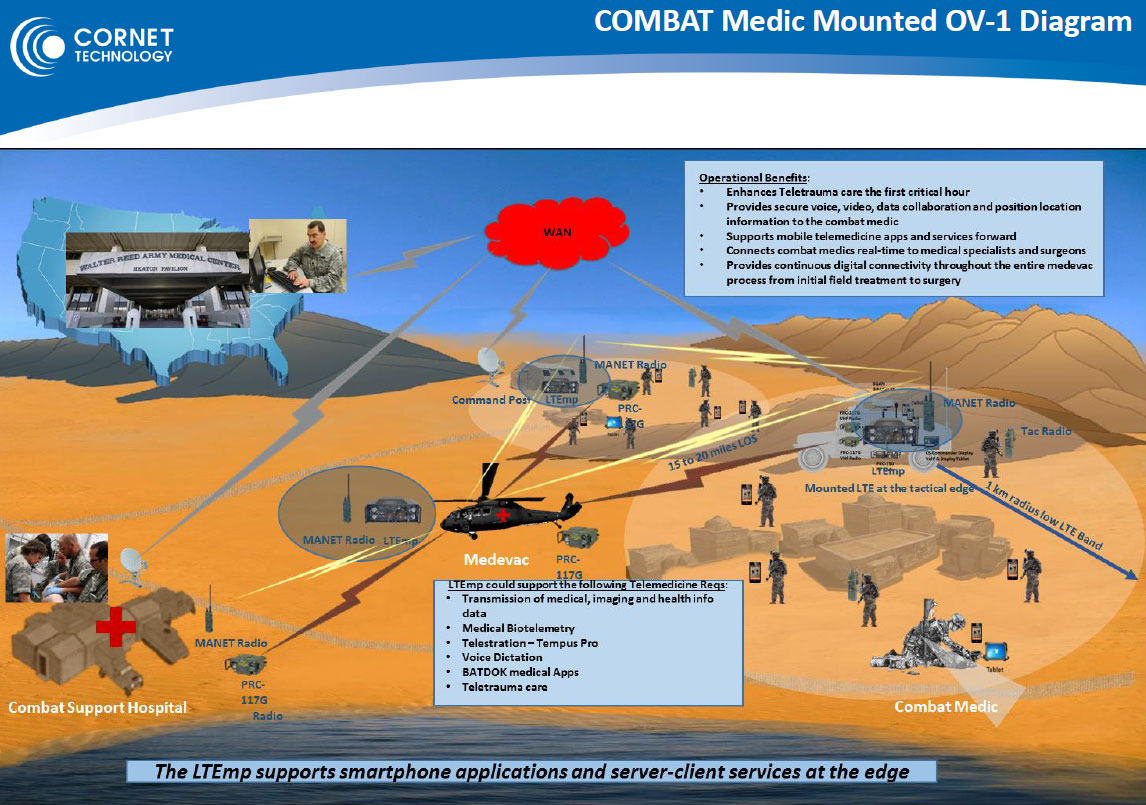MEDICAL ROBOTICS AND AUTONOMOUS SYSTEMS
TATRC Research Supports U.S. Navy Bureau of Medicine and Surgery
March 31, 2020 | Download PDF
On 10 January 2020, TATRC supported the U.S. Navy Bureau of Medicine and Surgery’s (BUMED) effort along with the John Hopkins Applied Physics Laboratory (JHU/APL) to characterize the use of the CORNET STINN 4G LTE Manpack Radio for use as a communications enabler for Virtual Health in a tactical environment.
During this one-day, outdoor field event hosted by TATRC, both U.S. Navy Hospital Corpsmen and Army Combat Medics teamed up to respond to medical scenarios where they jointly supported the care and treatment of a severely burned casualty in a simulated prolonged field care scenario. The medical teams used telemedicine technologies to reach back to clinicians at both Fort Detrick and to the Naval Medical Center in San Diego to receive mentorship and guidance allowing them to perform a simulated escharotomy. These clinical scenarios not only offered one-to-one training between a Physician and enlisted medical personnel, but also provided the network data that is required to characterize performance of the systems being studied.
During this event, subject-matter experts from two of TATRC’s key labs, demonstrated the maturation of capabilities to exploit network monitoring tools to characterize medical device network bandwidth requirements and the environment of the data collection event network. In addition to demonstrating TATRC’s network measurement capabilities, this event allowed TATRC staff to perform internal process improvements for performing reliable and accurate measurements to include validation of different tools for spectrum analysis, bandwidth capacity measurement, bandwidth utilization, jitter, and latency. The data obtained during this event showed that the telemedicine capabilities employed did not challenge the communications capabilities of the CORNET STINN 4G LTE Manpack Radio. These data collection capabilities will be employed in future data collection events to provide a characterization of the network environment and clinical device network requirements, if applicable for the study.
 Figure 1: Illustration of CEMM Concept
Figure 1: Illustration of CEMM Concept Performance improvement efforts were not limited to just the technical aspects, but also looked at internal processes for planning and execution of the data collection event. The study allowed for refinement of TATRC data collection processes before, during, and after execution of medical scenarios that will help identify the clinical impacts on patient care of emergent medical technologies. These improvement efforts will increase the quality and responsiveness of research endeavors to quickly answer Requests for Information from senior leaders.
The value of these exercises also go beyond performance improvement and research to answer senior leaders’ questions. These exercises also provide invaluable training opportunities for medical personnel to be challenged with medical scenarios that exceed their levels of training and scope of practice, and the opportunity for one-on-one instruction from Physicians through the use of telemedicine. U.S. Navy Captain Valerie Riege, Chief Innovation and Integration Officer at BUMED, highlighted the value of these experiences for all participants by stating, “Thank you very much for hosting the BUMED team for this highly interactive and immersive training session. The remote location, coupled with your excellent coordination, expertise, and willingness to support our demonstration resulted in an extremely productive day for all who attended!”
Execution of clinical scenarios in which data is being collected to answer leadership and program manager questions with government validated reproducible data, is resource intensive and a complex endeavor. Continued execution of these types of scenarios with incorporated internal process improvement, will result in an MRDC capability to perform early research to help inform material development decisions through employment of matured and repeatable processes.
This article was published in the September 2020 issue of the TATRC Times.